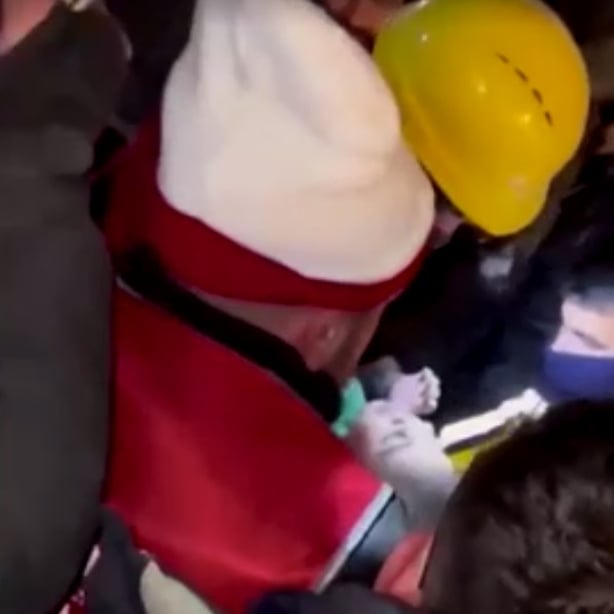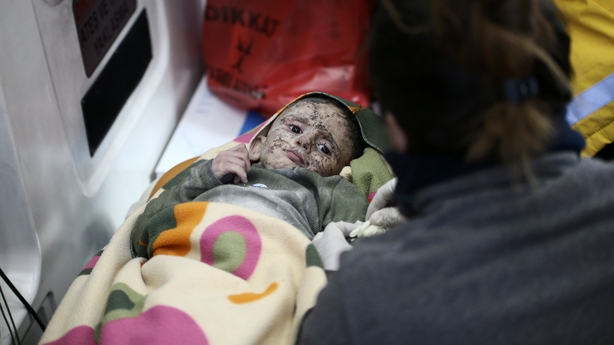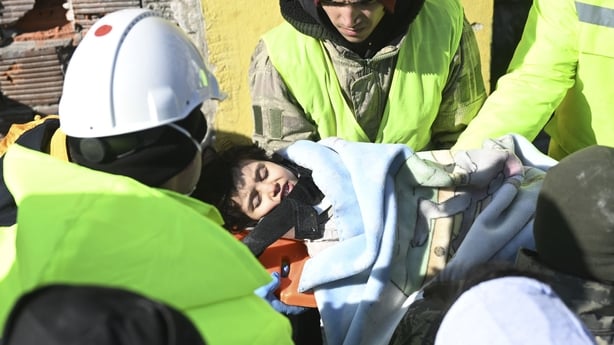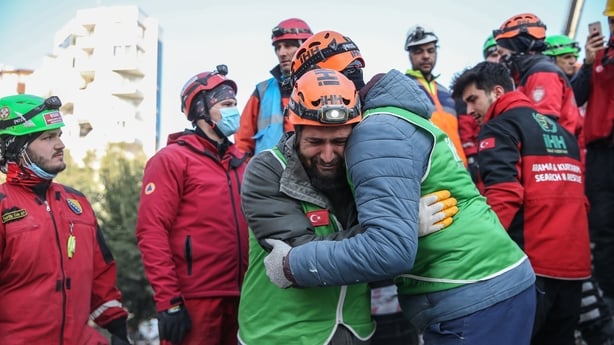Crouched under concrete slabs and whispering "inshallah" (God willing), the rescuers carefully reached into the rubble, then passed down the line their prize - a 10-day-old newborn who survived four days with his mother in the collapsed building.
His eyes wide open, Turkish baby Yagiz Ulas was wrapped in a shiny thermal blanket and carried to a field medical centre in Samandag, Hatay province.
Emergency workers also carried his mother, dazed and pale but conscious, on a stretcher, video images from Turkey's disaster agency showed.
Both were rushed to ambulances for medical examination.
Another man was rescued from the rubble of the same building.

The rescuers, including specialist teams from dozens of countries, toiled through the night in the ruins of thousands of wrecked buildings. In freezing temperatures, they regularly called for silence as they listened for any sound of life from mangled concrete mounds.
In the Turkish town of Kahramanmaras, 200km north of Samandag, orange-clad workers squeezed into an air pocket beneath a fallen building to find a toddler, crying as dust fell into his eyes, before relief settled over him and rescuers gently brushed his face clean, video from the Turkish defence ministry showed.
Further to the east of Turkey, the fearful face of another boy looked out from a pancaked building, his cries rising above the sound of the drills and grinders trying to free him this morning morning in the Kurdish-majority city of Diyarbakir, where the 7.8 magnitude earthquake and aftershocks turned apartment blocks into mounds of rubble and piles of shattered masonry.

After opening a wider hole, workers placed an oxygen mask on his face and carried him to safety. Like baby Yagiz, he was followed by his mother, on a stretcher, 103 hours after the earthquake struck.
And across the border in Syria, rescuers from the White Helmets group used bare hands to dig through plaster and cement, the air clouded with thick dust, until reaching the bare foot of a young girl, wearing pink pyjamas now grimy from days trapped, but alive and free at last.
We need your consent to load this rte-player contentWe use rte-player to manage extra content that can set cookies on your device and collect data about your activity. Please review their details and accept them to load the content.Manage Preferences
Teams also rescued a woman from the rubble of a collapsed building in Turkey this morning, prompting cheers from onlookers after around 104 hours since she was buried by the huge earthquake that wrought death and destruction across the region.
German emergency workers carefully lifted 40-year-old Zeynep Kahraman on a stretcher past shattered blocks of concrete and twisted metal in the town of Kirikhan into an ambulance.

"Now I believe in miracles," Steven Bayer, the leader of the International Search and Rescue team said at the site.
"You can see the people crying and hugging each other. It's such a huge relief that this woman under such conditions came out so fit. It's an absolute miracle," he said.
The combined death toll from the deadliest quake in the region in decades stands at 22,000 in southern Turkey and northwest Syria.
Hundreds of thousands more people have been left homeless and short of food in bleak winter conditions, desperate for a multi-national relief effort to alleviate their suffering.

Some of the heaviest devastation occurred near the quake's epicentre between Kahramanmaras and Gaziantep, where entire city blocks lay in ruins.
Turkey said almost 3,000 buildings had collapsed in seven different provinces, including public hospitals.
A famous mosque dating back to the 13th century partially collapsed in the province of Maltaya, where a 14-story building with 28 apartments that housed 92 people collapsed.
Social media posts showed a 2,200-year-old hilltop castle built by Roman armies in Gaziantep lying in ruins, its walls partially turned to rubble.
In Syria, the health ministry reported damage across the provinces of Aleppo, Latakia, Hama and Tartus, where Russia is leasing a naval facility.
The UN's cultural body UNESCO warned that two sites on its World Heritage List, the old city of Syria's Aleppo and the fortress in the southeastern Turkish city of Diyarbakir, had sustained damage and that several others may also have been hit.
Read more: Aid agency WFP running out of stock for quake survivors
It noted that the quake occurred in one of the longest continuously inhabited areas on the planet within the so-called Fertile Crescent, which has witnessed the emergence of different civilisations from the Hittites to the Ottomans.
Even before the tragedy, buildings in Aleppo often toppled due to poor infrastructure and many are dilapidated after more than a decade of war.
Azerbaijanis in Baku collect humanitarian aid to help those affected by Monday's earthquake
Large parts of Antakya in south-central Turkey - once the ancient city of Antioch - have been reduced to rubble.
The Syrian village of Tloul was flooded when a mud dam collapsed, leaving families to flee water that submerged houses, streets and crop fields.
Ratings agency Fitch said the quake could cause economic losses exceeding $4 billion.
Insured losses will be much lower, possibly around $1 billion, due to low insurance coverage in the area, it added.
